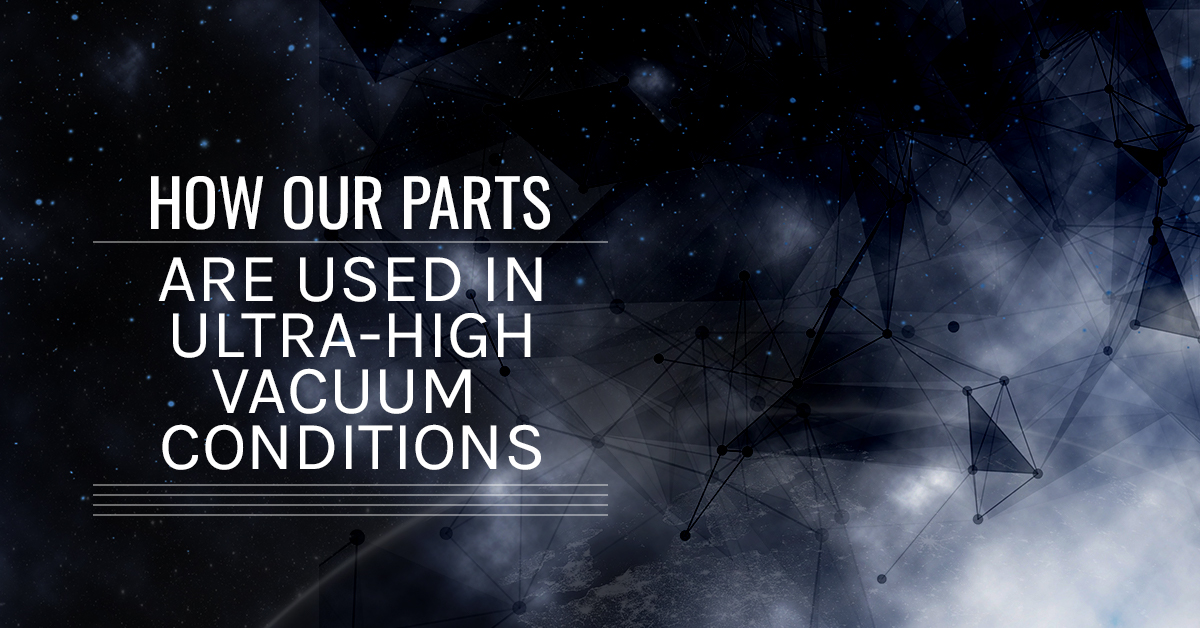How Our Parts Are Used in Ultra-High Vacuum Conditions
Mar 21st 2018

In our last blog, we touched upon what our vacuum pieces are and how they’re implemented into creating a ultra-high vacuum condition (UHV), and we made the distinction between a traditional vacuum and a ultra-high vacuum. In today’s blog, we’ll look more closely into how our vacuum fittings help to create a UHV in scientific labs for research purposes and discovery!
The UHV Materials
Because a UHV requires specific and niche variables such as pressure to conduct scientific experiments, the parts that go into creating a UVH chamber are quite peculiar and involve specific vacuum fittings, such as those by HyVac.
The variables introduced into the UHV chamber such as low-pressure and the chemical reactions that occur such as outgassing and through-gassing, make a majority of organic compound materials ineffective. A UHV is unable to use the following materials:
- Glues
- Plastics
- Carbon steel
- Lead
- Indium
Instead a variety of ceramics and metals (aluminum, copper and stainless steel) are used. At HyVac, we manufacture USA-made reusable stainless steel and aluminium vacuum fittings that meet and exceed industry standards and always include leak-tight sealing.
The Composition of a UHV
- A UHV is composed of the following:
- Multiple vacuum pumps
- Tubing
- Stainless steel metal chamber
- Bolts
- Bake system
- Chill chamber
The above components require our vacuum fittings and are available in the following sizes:
- NW16
- NW25
- NW40
- NW50
What The UHV is Used In
A UHV chamber is created and used in many scientific experiments including the following:
X-ray photoelectron spectroscopy (XPS) - This device is often used to analyze metal alloys, inorganic compounds, polymers, semiconductors, glasses, make-up, medical implants, and bones.
Auger electron spectroscopy (AES) - This device can create high-resolution chemical images to determine an underlying composition and whether a molecule is protonated or deprotonated.
Secondary ion mass spectrometry (SIMS) - This device is used to determine the components of cometary dust and of late, nuclear forensics.
In all of these surface analytical techniques, a UHV reduces surface contamination. At HyVac, our vacuum fittings prevent pressure leaks in the UHV chamber and lessen material breakdown in the baking stage. Because our parts are made from high-quality materials such as stainless steel and aluminum, it allows more experiments to be conducted without having to replace a part with every new run.
How Our Vacuum Fittings Are Involved in Exciting Science
Our vacuum fittings are involved in many scientific mechanisms that are conducting countless exciting scientific experiments.
A particle accelerator, also known as an “atom smasher” or “supercollider,” is a machine that propels charged particles through electromagnetic fields at virtually light-speed to encompass them into defined beams. Most notably, a particle accelerator known as CERN studies particle theory and condensed matter physics. The Large Hadron Collider (LHC) is biggest particle collider built over a 10-year period at CERN and has aided in measuring properties of the Higgs boson.
A gravitational wave detector is an instrument that measures gravitational waves and disruptions in spacetime. Recently the Advanced LIGO team detected gravitational waves from a black hole and in 2017, the Nobel Peace Prize in Physics awarded this discovery.
Atomic physics can also be associated with using a UHV for its research in nuclear power, and the research, because of its sensitive material, is mostly classified.
At HyVac, our parts may seem simple and straightforward, but their involvement in UHV chambers is advancing scientific discovery! We use UHV industry standard materials such as aluminum and stainless steel. Our vacuum fittings are also used in other devices such as XPS, AEs, and SIMS, while contributing to exciting scientific breakthroughs as the LHC, disruptions in spacetime in black holes, and atomic physics.
For a gallery of HyVac vacuum fittings search our inventory anytime online, or call us today for any questions about how our vacuum parts are used in UHV chambers.